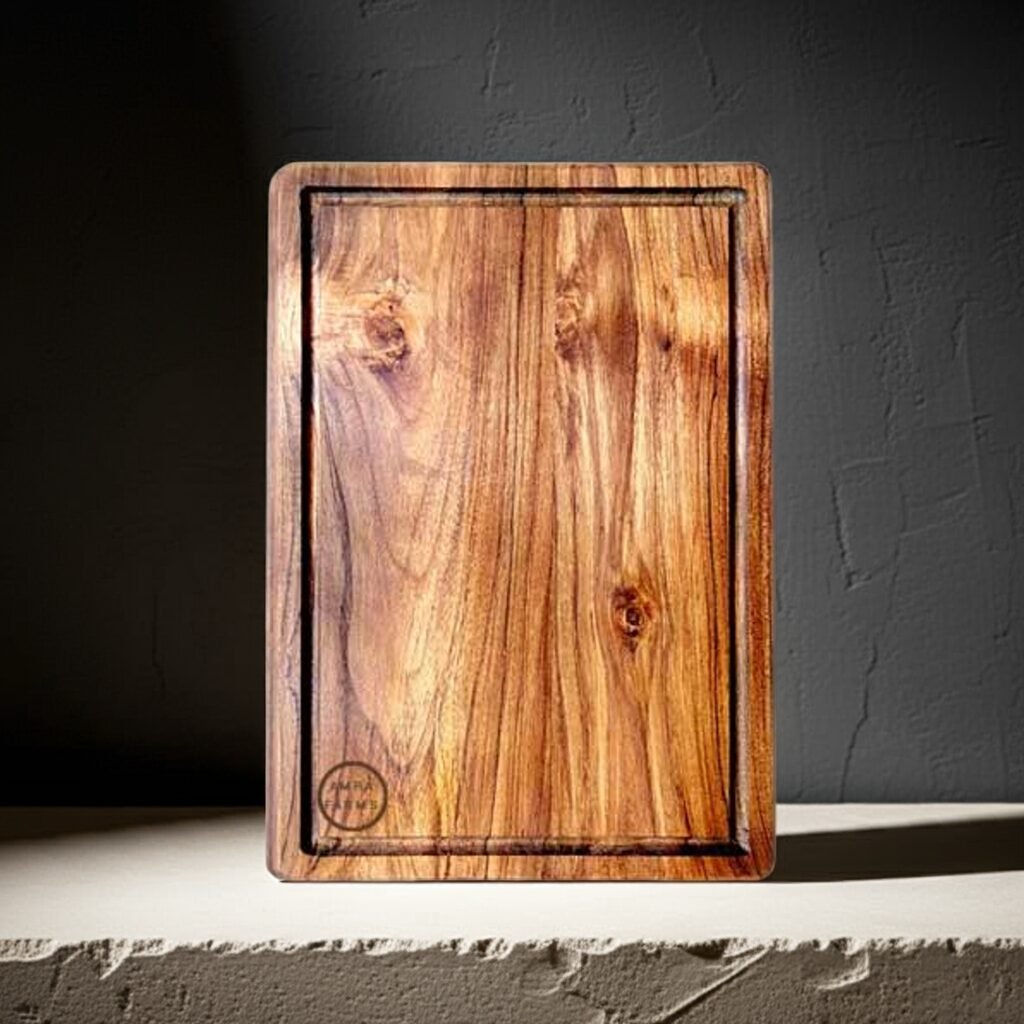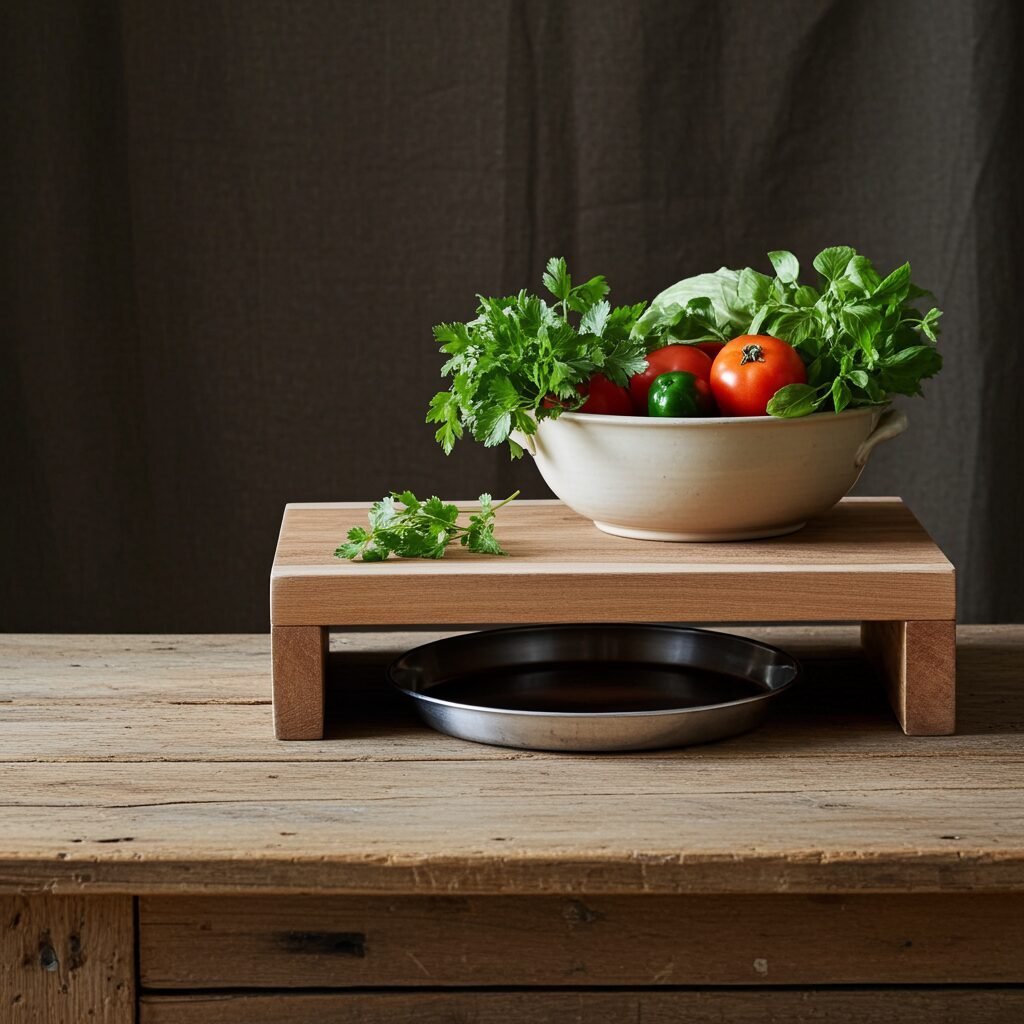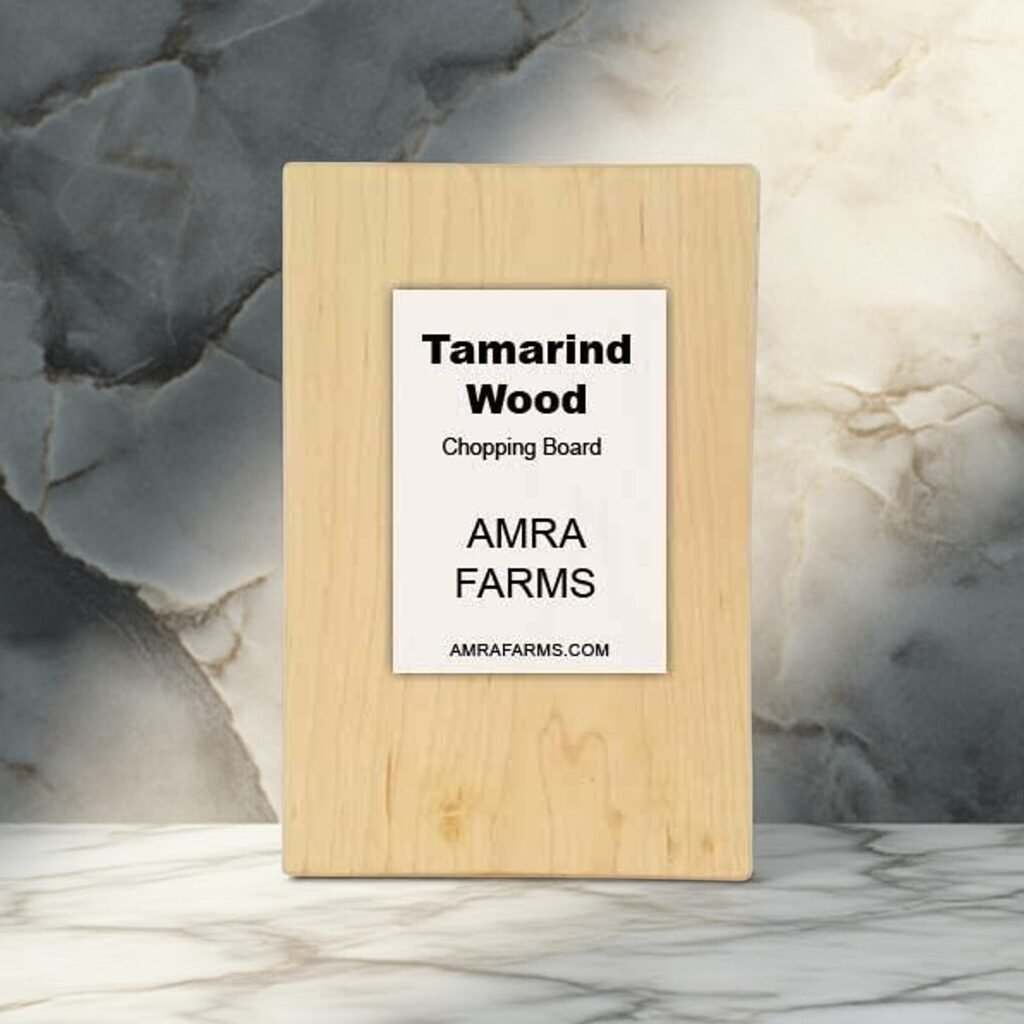Your cart is currently empty!
Why Teak is Becoming a Popular Wood for Cutting Boards
Teak was always considered premium quality since ages. In India, teak was a prized possession, used in furniture and construction where aesthetics, durability, and reliability were required. Till the late 1900s, teak was expensive because it was not abundantly cultivated. Considered a forest wood, it was available only at a very high price. With the cultivation of teak becoming more common in India and a 1.5 million hectare plantation of teak in India alone, teak has become more accessible. Today, teak is still a prized commodity but is still accessible to many.
Wooden cutting boards made of teak were not uncommon in the past. Since it required very little material, many homes in India used teak wood cutting boards in the past. Teak wood was known to be strong, durable, and long-lasting, making it a reasonable purchase for many homes. Today, teak wood is accessible, but people are worried about the originality of the wood, as many cheaper woods are passed off as teak. Premium wood cutting boards made of teak cost anywhere between 1500 and 3500 and even up to 10000 Rs. Many vendors sell sheesham and other cheaper woods in the name of teak, making it a concern for buyers and losing trust in purchasing wood that expensive.
Chef-recommended cutting boards made from teak are usually end-grain cutting boards. These are highly priced and could range anywhere between 5000 Rs and 10,000 Rs depending on the design, size, and construction.






Reasons for Teak’s Growing Popularity
- Durability & Longevity: Teak is a durable wood which could stand the test of time and has been proven to do so. There are buildings in India that have teak wood constructions that are 1000 years old. Also, boats are still built with teak wood because of its durability and water resistance.
- Knife Friendliness: When it comes to knife friendliness, teak is better than most other materials and stands between woods that are extremely hard and extremely soft, just in the right spot. Teak wood helps retain the knife’s sharpness for longer, increasing the life of your knife.
- Moisture Resistance & Hygiene: Teak wood is naturally moisture resistant. With high oil content, naturally found in teak wood, it is resistant to any drawbacks that cause problems due to moisture including mold, bacterial growth, and more.
- Low Maintenance: Teak wood is among the few woods that require minimal maintenance. While most other woods require some form of maintenance, teak wood is known to be in the best condition for years without maintenance, retaining its quality.
- Aesthetic Appeal: Teak wood is known for its beautiful golden brown colors which turn rustic gray as it ages. The beauty of teak is that with maintenance, you can retain the golden brown hue for as long as you wish. The dark brown color of the aged wood is preferred by many too.
- Eco-friendliness: Teak wood is becoming more and more sustainable with more and more plantations of teak. It is also eco-friendly as it is natural.
Professional chefs love teak wood cutting boards for their longevity and durability. Teak wood is a reliable wooden cutting board that can hold its weight, be sturdy on a platform, and counter heavy blows and chops without a problem. It is perfect for chopping vegetables, herbs, or meat without compromise. The antibacterial property of teak wood makes it ideal for handling raw meat, vegetables, and fruits.
What Makes a Great Cutting Board?
What are the most essential features you look for when purchasing a cutting board? Most homeowners would look for durability and longevity, easy maintenance, and a material that will be hygienic. When this is all met, they look for price. Aesthetics are important but not unless you want to purchase a cutting board to make cooking videos or if your home and kitchen have frequent guests. Knife friendliness is not usually a concern for many home chefs.
While teak wood ticks all the boxes for the right material for a cutting board, they do fall back on the price factor. But when you look for value, teak wood excels over most other materials too. Let me explain.
A teak wood cutting board for home is approximately 18 inches X 12 inches X 1 inch. This is a beautiful board and would cost you approximately 2000 Rs. The same-sized plastic board would cost you 499 on Amazon. If you had to compare both these boards side by side, which board do you think would be good in terms of value?
Teak Wood: Looks beautiful, lasts 10 years, requires monthly oiling and maintenance for 5-10 minutes a month. Durable, tough, antibacterial, you can use one side for meat and the other side for vegetables and fruits. You can also use it as a tray if the design permits. Annual resurfacing will give you a perfectly new board every year. Add that with its antibacterial properties of teak wood, and you already have a winner.
Plastic Board: Looks like a plastic board, of course. Bland, zero aesthetics. Durable for 1 year. Starts developing cracks which cannot be repaired. Starts trapping bacteria after six months. Looks terrible after the 6th month, even with deep cleaning.
Which one do you think is really of value? You would buy 10 plastic boards in 10 years and feel the joy of buying a new cutting board every year, for a few days. A teak board, on the contrary, will be your companion for a decade.
Plastic definitely has its own advantages. It is dishwasher safe. You can rough it up, leave it in the sink with all the other utensils to wash, and drown it in water for a week, and it will not have a problem. Teak requires maintenance and discipline.
The Natural Advantages of Teak Wood
Teak wood (Tectona Grandis) is a tropical hardwood native to the Indian subcontinent. Their exceptional quality makes it ideal for furniture, boat building, and construction. Their qualities of being antibacterial, moisture-resistant, scratch-resistant, dense, and durable make it a perfect material for cutting boards.
- High Density and Strength: The density of teak wood is 0.55 to 0.75 grams per centimeter cube. The older the tree, the higher the density. The growing conditions too account for the density of the wood. Plantation teaks are of lower density than forest teaks. Teak wood’s high density ensures higher bending strength, compressive strength, resistance to cracking, and its ability to resist cracks.
- Origin in Tropical Climate: Teak is a tropical tree and considered a forest tree. Their growth is very slow, and this results in tightly packed fibers, resulting in high stability and resistance to environmental changes, making it the perfect wood that remains in good form even in humid weather.
- Natural Oil Content: Teak is known for its rich oil content. The oil content in teak contains acetic acid, oxiranemethanol, phenol, 4-ethenyl-2-methoxy, propanoic acid, 2-oxo, levoglucosan, 1,2-cyclopentanedione, and isoeugenol. These oils help the wood retain its lustre and, more importantly, prevent bacterial growth and resist stains, making it look beautiful for a long time even without maintenance.
- Antibacterial: Teak wood is antibacterial. The dense fibers resist bacterial penetration and create a surface which is ideal for food preparation. Also, the oil content in teak kills bacteria when it comes in contact and reduces microbial activity.
- Scratch Resistance: One of the biggest concerns among home chefs and professional chefs is scratches on the surface of a cutting board. Teak wood is scratch-resistant and resists deep cuts and grooves. Also, the self-healing nature of wood ensures your cutting boards will be scratch-free for a longer period of time.
- Water Resistance: Teak wood’s natural oil helps resist moisture and water. Water slides through the wood naturally, and the tight fibers prevent absorption of water into the board.
Teak vs Other Popular Woods
Teak wood is considered superior, especially for its use as a cutting board due to its features. Comparing even wood like walnut puts teak ahead with its low maintenance and high oil content. Teak wood, in comparison with other materials like bamboo, is far superior as per research and experience from homeowners and professional chefs.
Teak vs Bamboo Cutting Board – Sustainability and Maintenance
Bamboo is a renewable resource and very eco-friendly. They are cheap and hard. Unfortunately, they are harder than required and often result in dulling knives and reducing the sharpness of knife edges. The dense fibers resist bacteria, but over time they develop a fuzzy surface due to a loss in fiber strength. When it comes to maintenance, bamboo boards require more frequent oiling than teak. Teak, on the other hand, resists scarring and is gentle on knives. They also require minimal maintenance. Teak wood costs more than bamboo, but its value is much higher due to the longevity of teak.
Acacia vs Teak Board and Walnut vs Teak Cutting Board – Aesthetic and Function
Acacia is a beautiful, eco-friendly wood with deep brown tones. It has a luxurious appearance. Regular oiling is required, and the surface is prone to scarring. Compared to teak, acacia is usually preferred for its aesthetics and deep tones. When it comes to durability and longevity, teak has the upper hand. Also, teak wood requires far less maintenance than acacia. Acacia wood is prone to warping and cracking if not maintained well.
Teak’s Longevity and Low Maintenance Appeal
Unlike other woods, teak is known for its durability and strength. It does not warp or crack, and the maintenance is very low. Less oiling is required as it is rich in its own oil. This is one reason why teak makes for long-lasting kitchen boards. Cutting boards that won’t warp usually require a thick profile, but teak is known for its ability to not warp even after years of use. As a low-maintenance wood, teak may seem expensive but is definitely worth buying.
Caring for Your Teak Cutting Board
Though cutting board maintenance is low, follow teak board care tips on our website to maintain your board. Be regular in your maintenance of your board. Oil your board at least once a month. Resurface your board when required and when you see a lot of scratches on the surface. Keep it out of direct sunlight and do not place hot objects on top of it.
Final Verdict – Is Teak the Best Choice?
So far, we have compared a lot of other woods for cutting boards, but none beats teak. We do sell and promote mango wood, tamarind, and even bamboo, but nothing excels the quality of teak wood for cutting boards. The only downside to a teak wood cutting board is its price. With more people going for value rather than price, we find a boom in teak wood being the choice for many customers, and we are sure that the trend will continue.
Categories
Products
- Buy Wooden Vegetable Cutting Boards Online
- Wooden Kitchen Accessories Tools
- Buy Butcher Block & Meat Cutting Boards Online
- Buy Premium Edge Grain Single Block Wooden Chopping Boards Online
- Buy The Best Teak Wood Chopping Boards Online In India
- Buy Wooden Cutting Boards With Handle For Kitchen
- Mango Wood Chopping Boards
- Tamarind Wood Chopping Boards
- Wooden Platter Boards , Pizza Platters & Charcuterie Boards
Tamarind Wood Cutting Board Teak Wood Cutting board
Recent Posts
- What to look for when purchasing a teak wood cutting board and how to identify teak wood
- Wooden chopping boards that naturally resist fungus/mould growth
- Cooking utensils that are best in wood
- Traditional, Timeless Kitchen Tools and Accessories – Things My Grandma Used
- Kitchen Tools Chefs Love and Cannot Live Without
